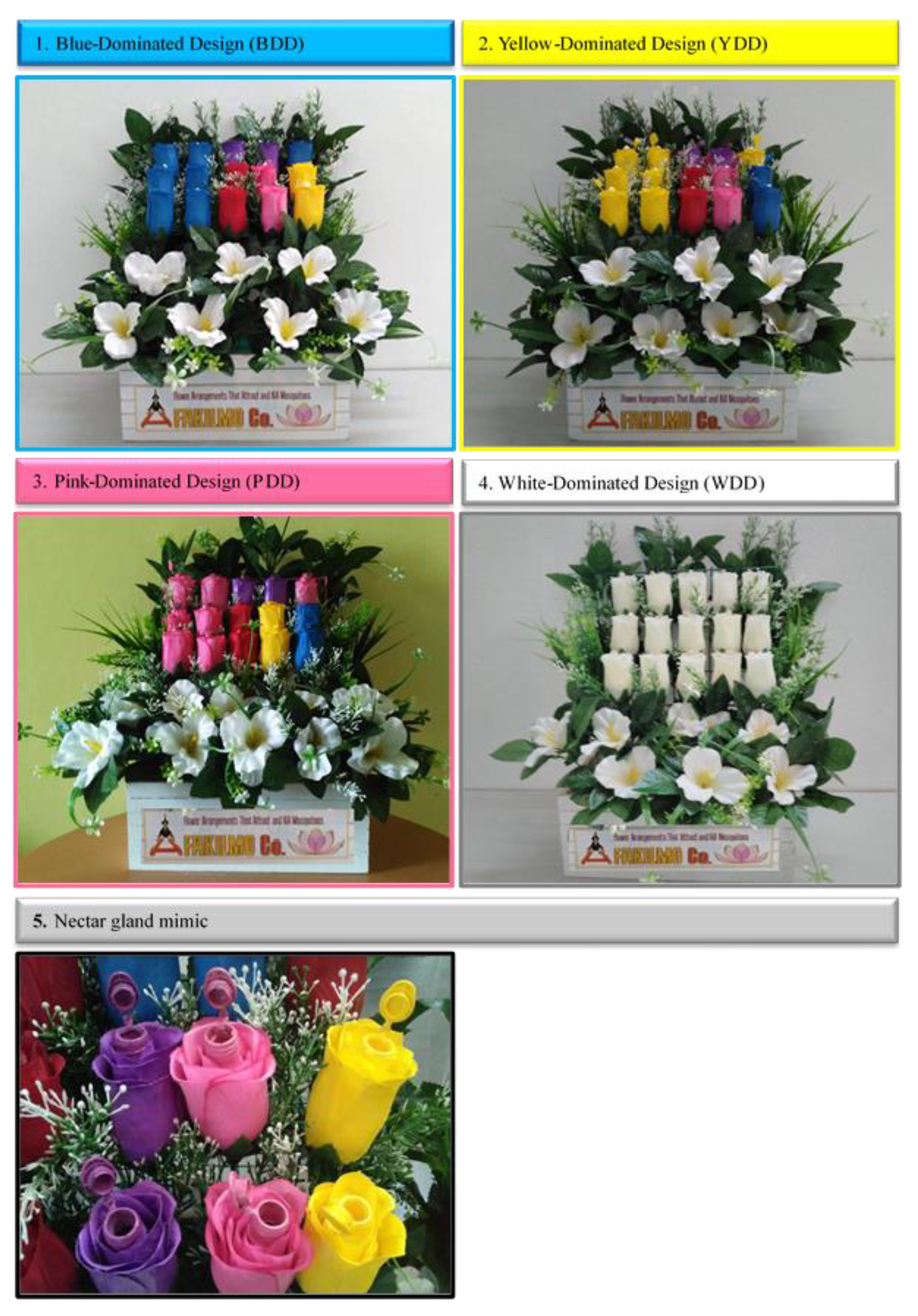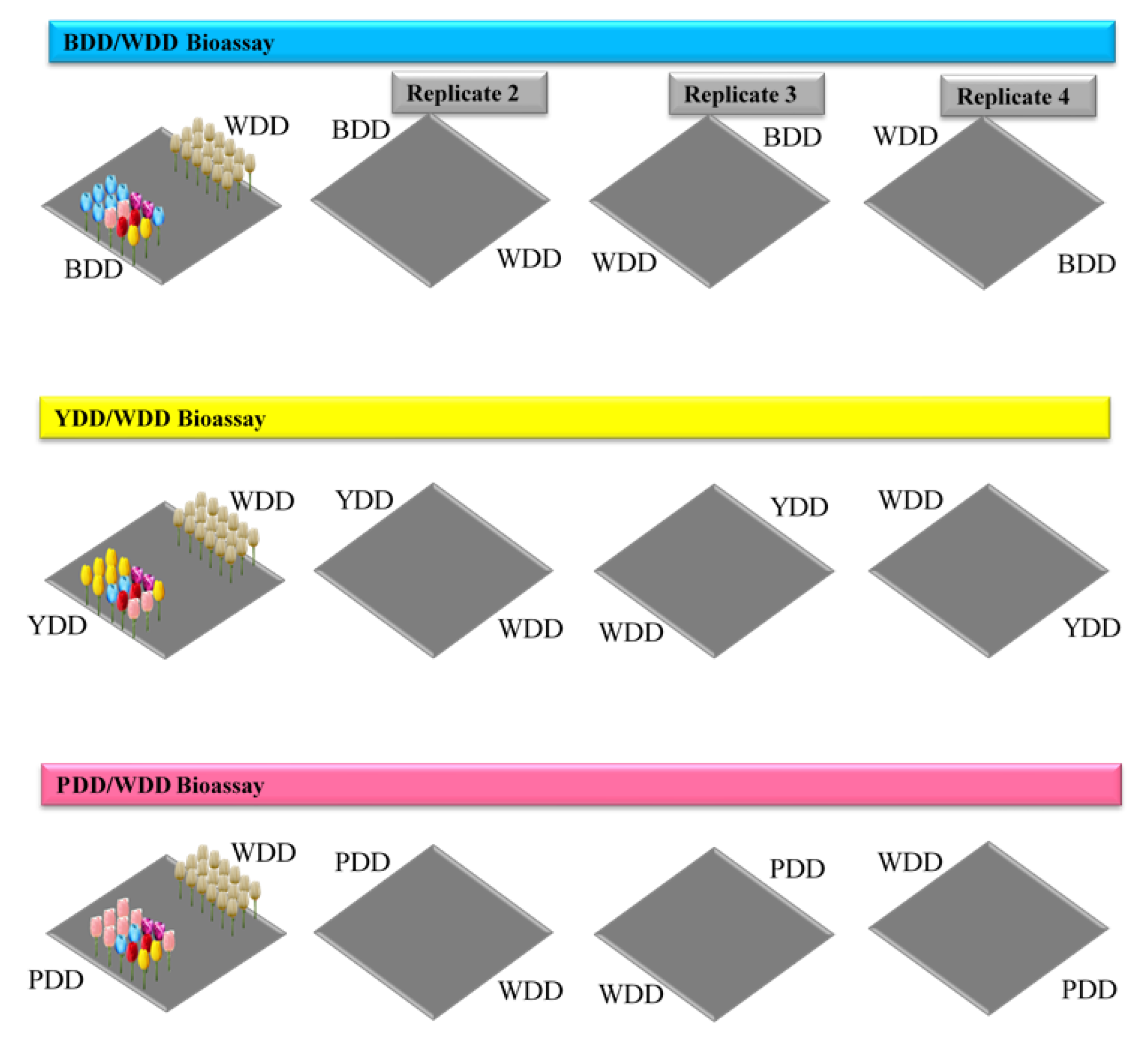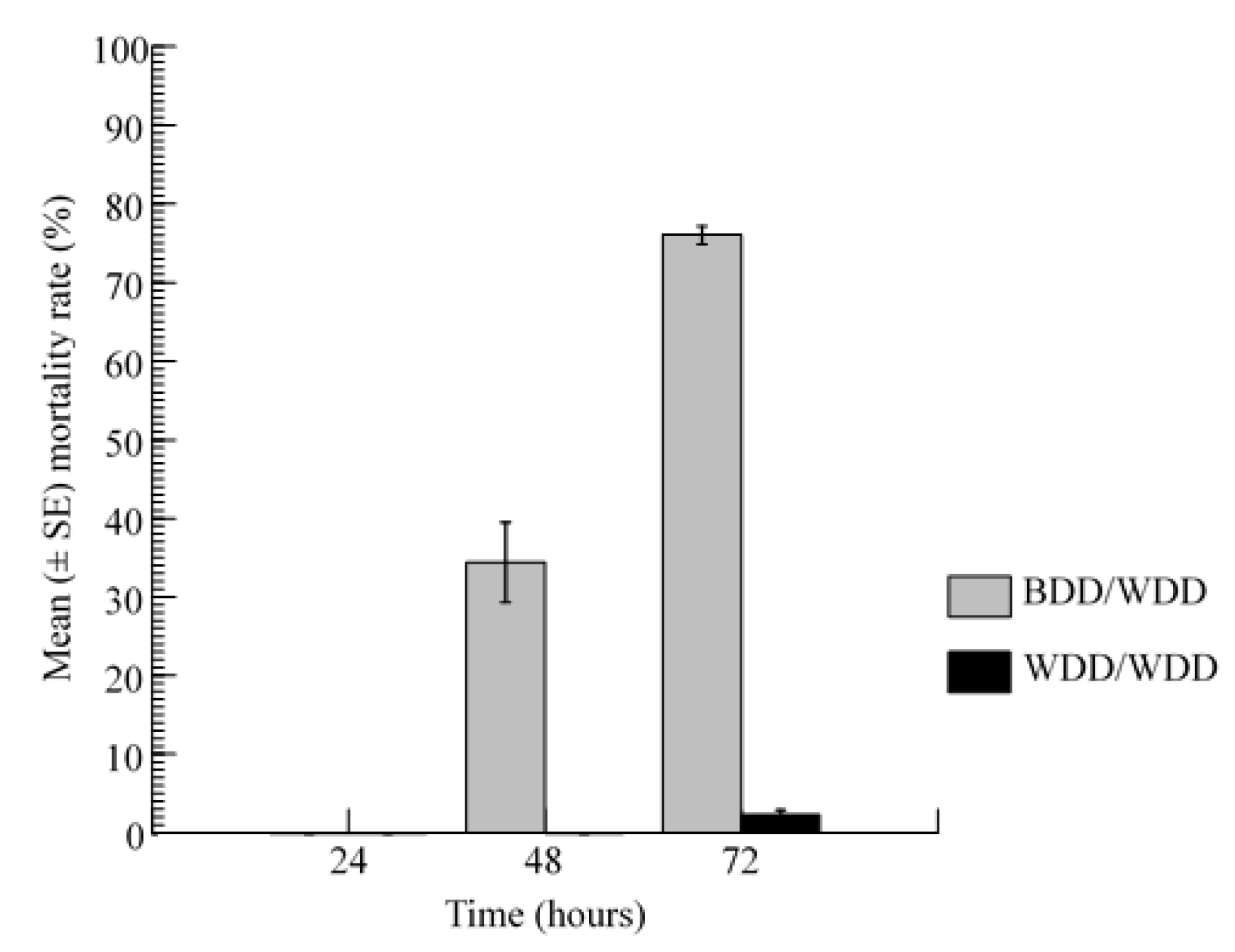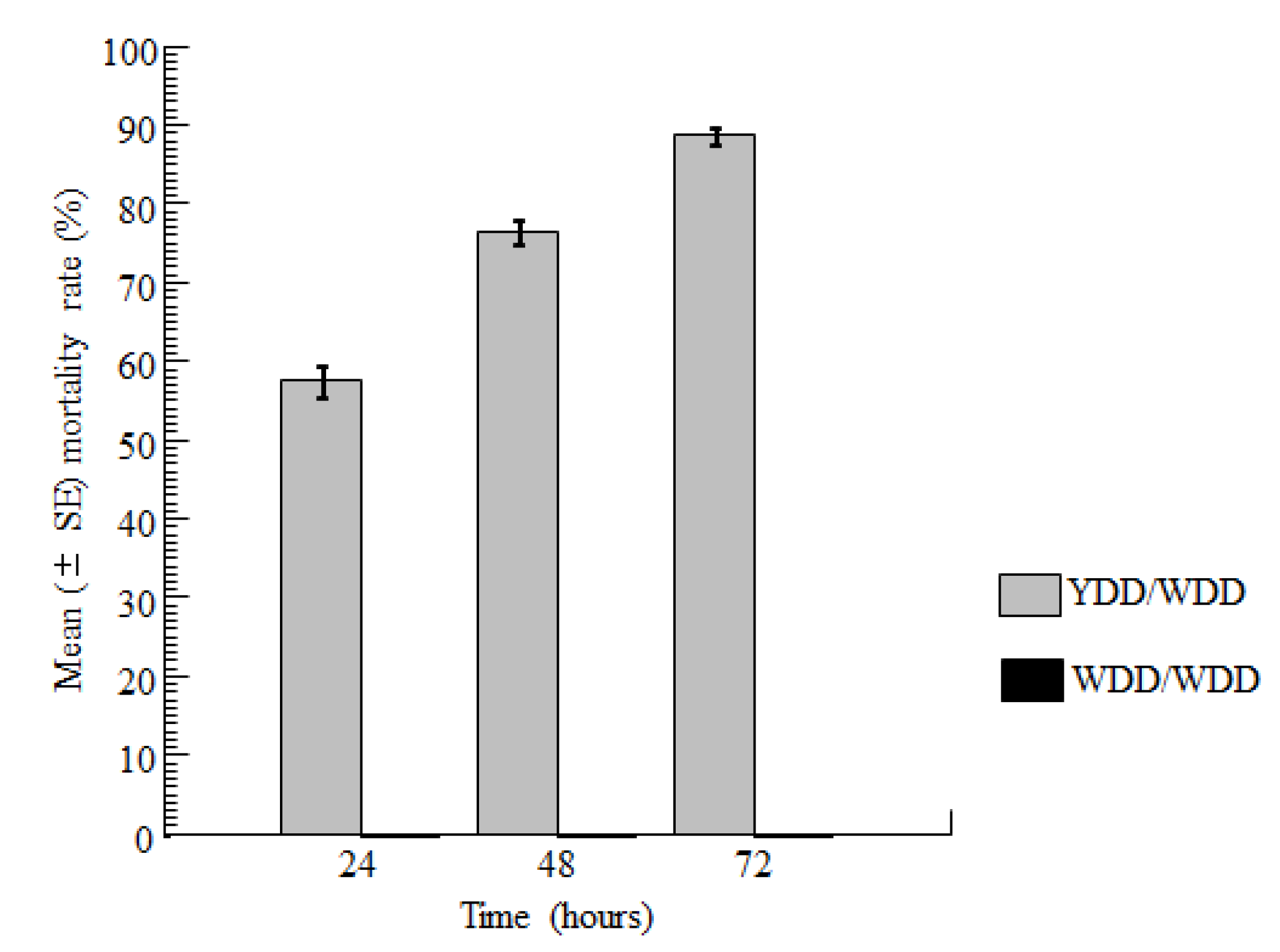Flower Mimics Roll Out Multicolored Carpets to Lure and Kill the House Fly
Abstract
:Simple Summary
Abstract
1. Introduction
2. Materials and Methods
2.1. Collection of Experimental House Flies
2.2. Artificial Flowers and Experimental Flower Arrangements
2.3. Production of Floral Designs
2.4. Bioassays
2.5. Data Collection and Statistical Analysis
3. Results
3.1. BDD and House Fly Mortality Rates
3.2. YDD and House Fly Mortality Patterns
3.3. PDD and House Fly Mortality Rates
4. Discussion
Author Contributions
Funding
Institutional Review Board Statement
Informed Consent Statement
Data Availability Statement
Conflicts of Interest
References
- Carlson, D.A.; Hogsette, J.A. Flybrella: A device to attract and kill house flies. J. Econ. Entomol. 2007, 100, 483–487. [Google Scholar] [CrossRef]
- Awache, I.; Farouk, A.A. Bacteria and Fungi Associated with Houseflies Collected from Cafeteria and Food Centres in Sokoto. FUW Trends Sci. Technol. J. 2016, 1, 123–125. [Google Scholar]
- Carter, D.B. Fly Trap and Bait Therefore; United States and Trademark Office: Washington, DC, USA, 2004; Volume 2. [Google Scholar]
- Courtney, G.W.; Cranston, P.S. Phylum Arthropoda: Order Diptera. In Thorp and Covich’s Freshwater Invertebrates; Ecology and General Biology; Thorp, J.H., Rogers, D.C., Eds.; Academic Press: London, UK, 2015; Volume 1, pp. 1043–1058. [Google Scholar]
- Khamesipour, F.; Lankarani, K.B.; Honarvar, B.; Kwenti, T.E. A systematic review of human pathogens carried by the housefly (Musca domestica L.). BMC Pub. Health 2018, 18, 1049. [Google Scholar] [CrossRef]
- Talley, J.L.; Wayadande, A.C.; Wasala, L.P.; Gerry, A.C.; Fletcher, J.; DeSilva, U.; Gilliland, S.E. Association of Escherichia coli O157:H7 with filth flies (Muscidae and Calliphoridae) captured in leafy greens fields and experimental transmission of E. coli O157:H7 to spinach leaves by house flies (Diptera: Muscidae). J. Food. Prot. 2009, 72, 1547–1552. [Google Scholar]
- Hung, K.Y.; Michailides, T.J.; Millar, J.G.; Wayadande, A.; Gerry, A.C. House Fly (Musca domestica L.) Attraction to insect honeydew. PLoS ONE 2015, 10, e0124746. [Google Scholar] [CrossRef]
- Dehgani, R.; Kassiri, H. A brief review on the possible role of houseflies and cockroaches in the mechanical transmission of Corona virus 2019 (COVID-19). Arch. Clin. Infect. Dis. 2020, 15, e102863. [Google Scholar]
- Khan, H.A.A.; Shad, S.A.; Akram, W. Combination of pagostimulant and visual lure as an effective tool in designing house fly toxic baits: A laboratory evaluation. PLoS ONE 2013, 8, e77225. [Google Scholar] [CrossRef] [Green Version]
- Wonthangsiri, D.P.; Pereira, R.M.; Bangs, M.J.; Koehler, P.G.; Chareoviriyaphap, T. Potential of attractive toxic sugar baits for controlling Musca domestica L., Drosophila melanogaster Meigen, and Megaselia scalaris Loew adult flies. Agric. Nat. Resour. 2018, 52, 393–398. [Google Scholar]
- Levchenko, M.A.; Silivanova, E.A.; Bikinyaeva, R.K.; Balabanova, G.F. Efficacy of acetamiprid and fipronil fly baits against the housefly (Musca domestica L.) under laboratory conditions. Vet. World 2018, 11, 953–958. [Google Scholar] [CrossRef] [Green Version]
- Geden, C.J. Visual targets for capture and management of house flies, Musca domestica L. J. Vect. Ecol. 2006, 31, 152–157. [Google Scholar] [CrossRef]
- Hertz, J.C.; Pereira, R.M.; Koehler, P.G. Housefly (Diptera: Musidae) resting preference on various cords & potential of fipronil- or indoxacab- impregnation on cords for fly control. J. Entomol. Sci. 2011, 46, 325–334. [Google Scholar]
- Hanley, M.E.; Dunn, D.W.; Abolins, S.R.; Goulson, D. Evaluation of (Z)-9-tricosene baited targets for control of the housefly (Musca domestica) in outdoor situations. J. Appl. Entomol. 2004, 128, 478–482. [Google Scholar] [CrossRef]
- Hardy, M.C. Resistance is not futile: It shapes insecticide discovery. Insects 2014, 5, 227–242. [Google Scholar] [CrossRef] [Green Version]
- Baker, D.; Rice, S.; Leemon, D.; Godwin, R.; James, P. Development of a Mycoinsecticide Bait Formulation for the Control of House Flies, Musca domestica L. Insects 2020, 11, 47. [Google Scholar] [CrossRef] [Green Version]
- Welch, R.M. Relative Effectiveness of Commercial Fly Traps and Ammonium Carbonate/Yeast in Catching Houseflies (Diptera: Muscidae). Master’s Thesis, University of Florida, Gainesville, FL, USA, 2006. [Google Scholar]
- Diclaro II, J.W.; Hertz, J.C.; Welch, R.M.; Koehler, P.G.; Pereira, R.M. Integration of fly baits, traps, and cords to kill house flies (Diptera: Muscidae) and reduce annoyance. J. Entomol. Sci. 2012, 47, 56–64. [Google Scholar] [CrossRef]
- Bell, M.; Irish, S.; Schmidt, W.P.; Nayak, S.; Clasen, T.; Cameron, M. Comparing trap designs and methods for assessing density of synanthropic flies in Odisha, India. Parasit. Vectors 2019, 12, 75. [Google Scholar] [CrossRef]
- Elvers, I. Pollen eating Thricops flies (Diptera, Muscidae) on Arrhenatherum pubescens and some other grasses. Bot. Not. 1980, 133, 49–52. [Google Scholar]
- Larson, B.M.H.; Kevan, P.G.; Inouye, D.W. Flies and flowers: Taxonomic diversity of anthophiles and pollinators. Can. Entomol. 2001, 133, 439–465. [Google Scholar] [CrossRef] [Green Version]
- Woodcock, T.S.; Larson, B.M.H.; Kevan, P.G.; Inouye, D.W.; Lunau, K. Flies and flowers II: Floral rewards and attractants. J. Poll. Ecol. 2014, 12, 63–94. [Google Scholar] [CrossRef]
- Stahl, J.; Nepi, M.; Galetto, L.; Guimaraes, E.; Machado, S. Functional aspects of floral nectar secretion of Ananas ananassoides, an Ornithophilous bromeliad from the Brazilian savanna. Ann. Bot. 2012, 109, 1243–1252. [Google Scholar] [CrossRef] [Green Version]
- Nicolson, S. Bee food: The chemistry and nutritional value of nectar, pollen and mixtures of the two. Afric. Zool. 2011, 46, 197–204. [Google Scholar] [CrossRef]
- Muller, M.; Katzberg, M.; Bertau, M.; Hummel, W. Highly efficient and stereoselective biosynthesis of (2S,5S)-hexanediol with a dehydrogenase from Saccharomyces erevisiae. Org. Biomol. Chem. 2010, 8, 1540. [Google Scholar] [CrossRef]
- Scott, H.G.; Littig, K.S. Flies of Public Health Importance and Their Control; Insect Control Series: Part 5; United States Department of Health, Education, and Welfare: Washington, DC, USA, 1962.
- Hertz, J.C. Potential of Insecticide-Treated Cords and Sprayable Baits for Control of House Flies (Diptera: Muscidae). Master’s Thesis, University of Florida, Gainesville, FL, USA, 2007. [Google Scholar]
- Codd, V.; Dolezel, D.; Stehlik, J.; Alberto, P.; Karen, J.; Racey, S.N.; Straatmaan, K.R.; Edward, J.L.; Costa, R.; Sauman, I.; et al. Circadian rhythm gene regulation in the housefly Musca domestica. Genetics 2007, 177, 1539–1551. [Google Scholar] [CrossRef] [Green Version]
- Lunau, K. Visual ecology of flies with particular reference to colour vision and colour preferences. J. Comp. Physiol. A 2014, 200, 497–512. [Google Scholar] [CrossRef]
- van der Kooi, C.J.; Stavenga, D.G.; Arikawa, K.; Belušič, G.; Kelber, A. Evolution of insect color vision: From spectral sensitivity to visual ecology. Annu. Rev. Entomol. 2021, 66, 435–461. [Google Scholar] [CrossRef]
- Salcedo, E.; Huber, A.; Henrich, S.; Chadwell, L.V.; Chou, W.; Paulsen, R.; Britt, S.G. Blue and green absorbing visual pigments of Drosophila: Ectopic expression and physiological characterization of the R8 photoreceptor cell-speciÞc Rh5 and Rh6 rhodopsin. J. Neurosci. 1999, 19, 10716–10726. [Google Scholar] [CrossRef] [Green Version]
- Waterhouse, D.F. The effect of colour on the numbers of houseflies resting on painted surfaces. Aust. J. Sci. Res. 1947, 1, 55–90. [Google Scholar]
- Tiusanen, M.; Hebert, P.D.N.; Schmidt, N.M.; Roslin, T. One fly to rule them all—Muscid flies are the key pollinators in the Arctic. Proc. R. Soc. B 2016, 283, 20161271. [Google Scholar] [CrossRef] [PubMed] [Green Version]
- Gegear, R.J. Multicomponent floral signals elicit selective foraging in bumblebees. Naturwissenschaften 2005, 92, 269–271. [Google Scholar] [CrossRef]
- Ohashi, K.; Thomson, J.T. Trapline foraging by pollinators: Its ontogeny, economics and possible consequences for plants. Ann. Bot. 2009, 103, 1365–1378. [Google Scholar] [CrossRef] [Green Version]
- Muth, M.; Papaj, D.R.; Leonard, A.S. Bees remember flowers for more than one reason: Pollen mediates associative learning. Anim. Behav. 2015, 111, 93–100. [Google Scholar] [CrossRef] [Green Version]
- Russell, A.L.; Papaj, D.R. Artificial pollen dispensing flowers and feeders for bee behaviour. J. Poll. Ecol. 2016, 18, 13–22. [Google Scholar] [CrossRef]
- Yoshioka, Y.; Ohashi, K.; Konuma, A.; Iwata, H.; Ohsawa, R.; Ninomiya, S. Ability of bumblebees to discriminate differences in the shape of artificial flowers of Primula sieboldii (Primulaceae). Ann. Bot. 2007, 99(6), 1175–1182. [Google Scholar] [CrossRef] [PubMed]
- Dieng, H.; Satho, T.; Binti Arzemi, N.A.; Aliasan, N.E.; Abang, F.; Wydiamala, E.; Miake, F.; Zuharah, W.F.; Abu Kassim, N.F.; Morales Vargas, R.E.; et al. Exposure of a diurnal mosquito vector to floral mimics: Foraging responses, feeding patterns, and significance for sugar bait technology. Acta Trop. 2018, 185, 230–238. [Google Scholar] [CrossRef] [PubMed]
- Keasar, T. The spatial distribution of nonrewarding artificial flowers affects pollinator attraction. Anim. Behav. 2000, 60, 639–646. [Google Scholar] [CrossRef] [PubMed] [Green Version]
- Essenberg, C. Flobots: Robotic flowers for bee behaviour experiments. J. Poll. Ecol. 2015, 15, 1–5. [Google Scholar] [CrossRef]
- Biesmeijer, J.C.; Giurfa, M.; Koedam, D.; Potts, S.G.; Joel, D.M.; Dafni, A. Convergent Evolution: Floral guides, stingless bee nest entrances, and insectivorous pitchers. Naturwissenschaften 2005, 92, 444–450. [Google Scholar] [CrossRef]
- Valentin, S.; Lunau, K.; Johnson, S. Choice experiments using artificial flowers reveal colour preferences of longproboscid flies (Nemestrinidae) under field conditions. Entomol. Heute 2006, 18, 113–122. [Google Scholar]
- Browne, S.M.; Benette, G.F. Response of mosquito (Diptera: Culicidae) to visual stimuli. J. Med. Entomol. 1981, 18, 505–521. [Google Scholar] [CrossRef]
- Shipman, N.M. Role of Color and Odor on the Attraction of Insect Visitors to Spring Blooming Trillium. Master’s Thesis, Western Carolina University, Cullowhee, NC, USA, 2011. [Google Scholar]
- Lu, W.; Casanueva, M.O.; Mahowald, A.P.; Kato, M.; Lauterbach, D.; Ferguson, E.L. Niche-associated activation of Rac promotes the asymmetric division of Drosophila female germline stem cells. PLoS Biol. 2012, 10, e1001357. [Google Scholar] [CrossRef] [Green Version]
- Burg, J.C.; Axtell, R.C. Monitoring house fly, Musca domestica (Diptera: Muscidae), populations in caged layer poultry houses using a baited jug-trap. Environ. Entomol. 1984, 13, 1085–1090. [Google Scholar] [CrossRef]
- Shimoda, M.; Honda, K. Insect reactions to light and its applications to pest management. Appl. Entomol. Zool. 2013, 48, 413–421. [Google Scholar] [CrossRef] [Green Version]
- Raine, N.E.; Chittka, L. Nectar production rates of 75 bumblebee-visited flower species in a German flora (Hymenoptera: Apidae: Bombus terrestris). Entomol. Gen. 2007, 30, 191–192. [Google Scholar] [CrossRef]
- Devi, M.S.; Roy, K. Comparable study on different coloured sticky traps for catching of onion thrips, Thrips tabaci Lindeman. J. Entomol. Zool. Stud. 2017, 5, 669–671. [Google Scholar]
- Culin, J.D. Relationship of butterfly visitation with nectar qualities and flower color in butterfly bush, Buddleia davidii. News Lepid. Soc. 1997, 39, 35–38. [Google Scholar]
- Reverté, S.; Gomez, J.M.; Bosch, J. Pollinators show flower colour preferences but flowers with similar colours do not attract similar pollinators. Ann. Bot. 2016, 118, 249–257. [Google Scholar] [CrossRef] [Green Version]
- Stewart, Z.P.; Oxborough, R.M.; Tungu, P.K.; Kirby, M.J.; Rowland, M.W.; Irish, S.R. Indoor Application of Attractive Toxic Sugar Bait (ATSB) in Combination with Mosquito Nets for Control of Pyrethroid-Resistant Mosquitoes. PLoS ONE 2013, 8, e84168. [Google Scholar] [CrossRef] [PubMed]
- Qualls, W.A.; Müller, G.C.; Traoré, S.F.; Traoré, M.M.; Arheart, K.L.; Doumbia, S.; Schlein, Y.; Kravchenko, V.D.; Xue, R.D.; Beier, J.C. Indoor use of attractive toxic sugar bait (ATSB) to effectively control malaria vectors in Mali, West Africa. Malar. J. 2015, 14, 301. [Google Scholar] [CrossRef] [Green Version]
- Fiorenzano, J.M.; Koehler, P.G.; Xue, R.D. Attractive toxic sugar bait (ATSB) for control of mosquitoes and its impact on non-target organisms: A review. Int. J. Environ. Res. Pub. Health 2017, 14, 398. [Google Scholar] [CrossRef] [Green Version]
- Sippy, R.; Rivera, G.E.; Sanchez, V.; Heras, F.; Morejón, B.; Beltrán, E.; Hikida, R.S.; López-Latorre, M.A.; Aguirre, A.; Stewart-Ibarra, A.M.; et al. Ingested insecticide to control Aedes aegypti: Developing a novel dried attractive toxic sugar bait device for intra-domiciliary control. Parasit. Vectors 2020, 13, 78. [Google Scholar] [CrossRef] [Green Version]
- Konzmann, S.; Lunau, K. Divergent rules for pollen and nectar foraging bumblebees—A laboratory study with artificial flowers offering diluted nectar substitute and pollen surrogate. PLoS ONE 2014, 9, e91900. [Google Scholar] [CrossRef] [Green Version]
- Baracchi, D.; Marples, A.; Jenkins, A.J.; Leitch, A.R.; Chittka, L. Nicotine in floral nectar pharmacologically influences bumblebee learning of floral features. Sci. Rep. 2017, 7, 1951. [Google Scholar] [CrossRef] [Green Version]
- Hogsette, J.A.; Carlson, D.A.; Nejame, A.S. Development of Granular boric acid sugar baits for house flies (Diptera:Muscidae). J. Econ. Entomol. 2002, 95, 1110–1112. [Google Scholar] [CrossRef] [PubMed]
- Pickering, C.M.; Stock, M. Insect colour preference compared to flower colours in the Australian alps. Nordic J. Bot. 2008, 23, 217–223. [Google Scholar] [CrossRef]
- Satho, T.; Dieng, H.; Muhammad Hishamuddin, I.A.; Salbiah, B.E.; Abu Hassan, A.; Abang, F.B.; Ghani, I.A.; Miake, F.; Hamdan, A.; Yuki, F.; et al. Coffee and its waste repel gravid Aedes albopictus females and inhibit the development of their embryos. Parasit. Vectors 2015, 8, 272. [Google Scholar] [CrossRef] [PubMed] [Green Version]
- Systat Software Inc. Systat 11 Data. Systat for Windows: Statistics; Systat Software Inc.: Richmond, VA, USA, 2004. [Google Scholar]
- Weiss, M.R.; Lamont, B.B. Floral color change and insect pollinators: A dynamic relationship. Isr. J. Plant Sci. 1997, 45, 183–199. [Google Scholar] [CrossRef]
- Ghazhoul, J. Floral diversity and the facilitation of pollination. J. Ecol. 2006, 94, 295–304. [Google Scholar] [CrossRef]
- Ye, Z.M.; Dai, W.K.; Jin, X.F.; Gituru, R.W.; Wang, Q.F.; Yang, C.F. Competition and facilitation among plants for pollination: Can pollinator abundance shift the plant-plant interactions? Plant Ecol. 2014, 215, 3–13. [Google Scholar] [CrossRef]
- Moeller, D.A. Facilitative interactions among plants via pollinators. Ecology 2004, 85, 3289–3301. [Google Scholar] [CrossRef] [Green Version]
- Hunter, N.T. The Art of Floral Design, 3rd ed.; Delmar Cengage Learning: Toronto, ON, Canada, 2013. [Google Scholar]
- Glimn-Lacy, J.; Kaufman, P.B. Botany Illustrated: Introduction to Plants, Major Groups, Flowering Plant; Springer: Berlin/Heidelberg, Germany, 1984. [Google Scholar]
- Raine, N.E.; Chittka, L. The adaptive significance of sensory bias in a foraging context: Floral colour preferences in the bumblebee Bombus terrestris. PLoS ONE 2007, 2, e556. [Google Scholar] [CrossRef] [Green Version]
- Acharya, R.S.; Leslie, T.; Fitting, E.; Burke, J.; Loftin, K.; Joshi, N.K. Color of pan trap influences sampling of bees in livestock pasture ecosystem. Biology 2021, 10, 445. [Google Scholar] [CrossRef]
- Moyroud, E.; Wenzel, T.; Middleton, R.; Rudall, P.J.; Banks, H.; Reed, A.; Mellers, G.; Killoran, P.; Westwood, M.M.; Steiner, U.; et al. Disorder in convergent floral nanostructures enhances signalling to bees. Nature 2017, 550, 469–474. [Google Scholar] [CrossRef]
- Strother, G.K.; Casella, A.J. Microspectrophotometry of arthropod visual screening pigments. J. Gen. Physiol. 1972, 59, 616–636. [Google Scholar] [CrossRef] [PubMed] [Green Version]
- Hardie, R.C. Properties of photoreceptors R7 and R8 in dorsal marginal ommatidia in the compound eyes of Musca and Calliphora. J. Comp. Physiol. A 1984, 154, 152–175. [Google Scholar] [CrossRef]
- Hardie, R.C. The photoreceptor array of the dipteran retina. Trends Neurosci. 1986, 9, 419–423. [Google Scholar] [CrossRef]
- Awati, P.R.; Swaminath, C.S. Bionomics of houseflies. III. A preliminary note on attraction of houseflies to certain fermenting and putrefying substances. Indian J. Med. Res. 1920, 7, 560–567. [Google Scholar]
- Nava, A. Preferencias de Musca domestica en la Seleccion de Superficies de Color. Master’s Thesis, Instituto Politecnico Nacional, Mexico City, Mexico, 1967. [Google Scholar]
- Hecht, O.; Muniz, R.; Nava, A. Contrary responses of Musca domestica concerning their selection of different shades and hues. Entomol. Exp. Appl. 1968, 11, 1–14. [Google Scholar] [CrossRef]
- Byrne, D.N.; Von Bretzel, P.K.; Hoffman, C.J. Impact of trap design and placement when monitoring for the bandedwinged whitefly and the sweetpotato whitefly (Homoptera: Aleyrodidae). Environ. Entomol. 1986, 15, 300–304. [Google Scholar] [CrossRef]
- Yee, W.L. Evaluation of yellow rectangle traps coated with hot melt pressure sensitive adhesive and sticky gel against Rhagoletis indifferens (Diptera: Tephritidae). J. Econ. Entomol. 2011, 104, 909–919. [Google Scholar] [CrossRef]
- Lina, A.N.; Neimann, A.; Eberling, E.; Algora, H.; Brings, S.; Lunau, K. The yellow specialist: Dronefly Eristalis tenax prefers different yellow colours for landing and proboscis extension. J. Exp. Biol. 2018, 221, jeb184788. [Google Scholar]
- Binkenstein, J.; Stang, M.; Renoult, J.P.; Schaefer, H.M. Weak correlation of flower color and nectar-tube depth in temperate grasslands. J. Plant Ecol. 2016, 10, 397–405. [Google Scholar] [CrossRef] [Green Version]
- Zhang, C.; Vereecken, N.J.; Wang, L.; Tian, B.; Dafni, A.; Yongping, Y.; Duan, Y. Are nectar guide colour changes a reliable signal to pollinators that enhances reproductive success? Plant Ecol. Divers. 2017, 10, 89–96. [Google Scholar] [CrossRef]
- Struwe, G. Spectral sensitivity of the compound eye in butterflies (Heliconius). J. Comp. Physiol. 1972, 79, 191–196. [Google Scholar] [CrossRef]
- du Plessis, M.; Johnson, S.; Nicolson, S.; Bruyns, P.; Shuttleworth, A. Pollination of the “carrion flowers” of an African stapeliad (Ceropegia mixta: Apocynaceae): The importance of visual and scent traits for the attraction of flies. Plant Syst. Evol. 2017, 304, 357–372. [Google Scholar] [CrossRef]
- Tenorio, J.M.; Nishida, G.M. What’s Bugging Me? University of Hawaii Press: Honolulu, HI, USA, 1995. [Google Scholar]
- Murvosh, C.H.; Fye, R.L.; Labrecque, G.C. Studies on the mating behavior of the house fly, Musca domestica. Ohio J. Sci. 1964, 64, 264. [Google Scholar]
- Kearns, C.A. Flies and flowers: An enduring partnership. Wings 2002, 25, 3–8. [Google Scholar]
- Kevan, P. Flowers, pollination, and the associated diversity of flies. Biodiversity 2002, 3, 16–18. [Google Scholar]
- Symank, A.; Kearns, C.A.; Thomas, P.; Christian, T.F. Pollinating flies (Diptera): A major contribution to plant diversity and agricultural production. Biodiversity 2008, 9, 86–89. [Google Scholar] [CrossRef]
- Chow, C.Y.; Thevasagayam, E.S. A simple and effective device for housefly control with insecticide. Bull. World Health Org. 1953, 8, 491–495. [Google Scholar]
- Murlis, J.; Elkinton, J.S.; Carde, R.T. Odor plumes and how insects use them. Annu. Rev. Entomol. 1992, 37, 505–532. [Google Scholar] [CrossRef]
- Huston, S.J.; Stopfer, M.; Cassenaer, S.; Aldworth, Z.N.; Laurent, G. Neural encoding of odors during active sampling and in turbulent plumes. Neuron 2015, 88, 403–418. [Google Scholar] [CrossRef] [PubMed] [Green Version]
- Hoornweg, D.; Bhada-Tata, P. What a Waste: A Global Review of Solid Waste Management; Urban Development Series Knowledge Papers no. 15; World Bank: Washington, DC, USA, 2012; Available online: https://openknowledge.worldbank.org/handle/10986/17388 (accessed on 24 May 2020).
- Pharino, C. Challenges for Sustainable Solid Waste Management, Springerbriefs on Case Studies of Sustainable Development; Springer Nature: Singapore, 2017. [Google Scholar]
- Murlis, J.; Willis, M.A.; Carde, R.T. Spatial and temporal structures of pheromone plumes in fields and forests. Physiol. Entomol. 2000, 25, 211–222. [Google Scholar] [CrossRef]
- Moser, P. Out of Control? Managing Baseline Variability in Experimental Studies with Control Groups. In Good Research Practice in Non-Clinical Pharmacology and Biomedicine; Bespalov, A., Michel, M., Steckler, T., Eds.; Handbook of Experimental Pharmacology; Springer: Cham, Switzerland, 2019; Volume 257. [Google Scholar]
- Hogsette, J.A.; Koehler, P.G. Comparative toxicity of aqueous solutions of boric acid and polybor 3 to house flies (Diptera: Muscidae). J. Econ. Entomol. 1992, 85, 1209–1212. [Google Scholar] [CrossRef] [Green Version]





| Study | Enclosure | Replication | Data Collection Time |
|---|---|---|---|
| BDD and house fly mortality responses | Test enclosure: BDD vs. WDD Control enclosure: WDD vs. WDD | 4 6 | 24, 48, 72 hours |
| YDD and house fly mortality responses | Test enclosure: YDD vs. WDD Control enclosure: WDD vs. WDD | 4 5 | 24, 48, 72 hours |
| PDD and house fly mortality responses | Test enclosure: PDD vs. WDD Control enclosure: WDD vs. WDD | 4 5 | 24, 48, 72 hours |
Publisher’s Note: MDPI stays neutral with regard to jurisdictional claims in published maps and institutional affiliations. |
© 2021 by the authors. Licensee MDPI, Basel, Switzerland. This article is an open access article distributed under the terms and conditions of the Creative Commons Attribution (CC BY) license (https://creativecommons.org/licenses/by/4.0/).
Share and Cite
Dieng, H.; Satho, T.; Mohd Radzi, N.H.S.B.; Abang, F.; A. Kassim, N.F.; Zuharah, W.F.; Hashim, N.A.; Morales Vargas, R.E.; Morales, N.P. Flower Mimics Roll Out Multicolored Carpets to Lure and Kill the House Fly. Insects 2021, 12, 1097. https://doi.org/10.3390/insects12121097
Dieng H, Satho T, Mohd Radzi NHSB, Abang F, A. Kassim NF, Zuharah WF, Hashim NA, Morales Vargas RE, Morales NP. Flower Mimics Roll Out Multicolored Carpets to Lure and Kill the House Fly. Insects. 2021; 12(12):1097. https://doi.org/10.3390/insects12121097
Chicago/Turabian StyleDieng, Hamady, Tomomitsu Satho, Nor Hafisa Syafina Binti Mohd Radzi, Fatimah Abang, Nur Faeza A. Kassim, Wan Fatma Zuharah, Nur Aida Hashim, Ronald E. Morales Vargas, and Noppawan P. Morales. 2021. "Flower Mimics Roll Out Multicolored Carpets to Lure and Kill the House Fly" Insects 12, no. 12: 1097. https://doi.org/10.3390/insects12121097
APA StyleDieng, H., Satho, T., Mohd Radzi, N. H. S. B., Abang, F., A. Kassim, N. F., Zuharah, W. F., Hashim, N. A., Morales Vargas, R. E., & Morales, N. P. (2021). Flower Mimics Roll Out Multicolored Carpets to Lure and Kill the House Fly. Insects, 12(12), 1097. https://doi.org/10.3390/insects12121097







